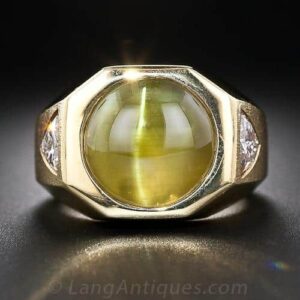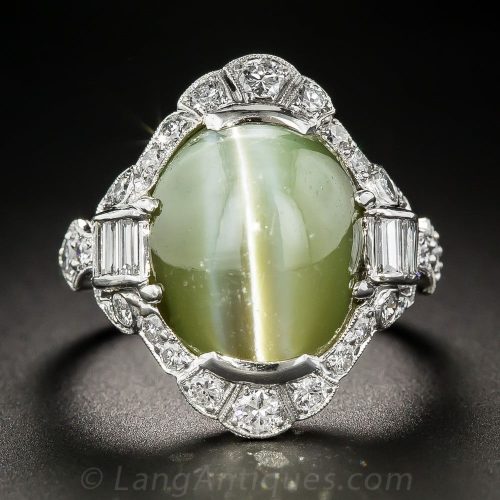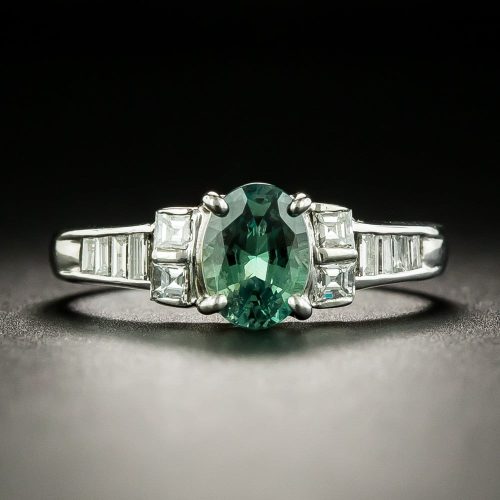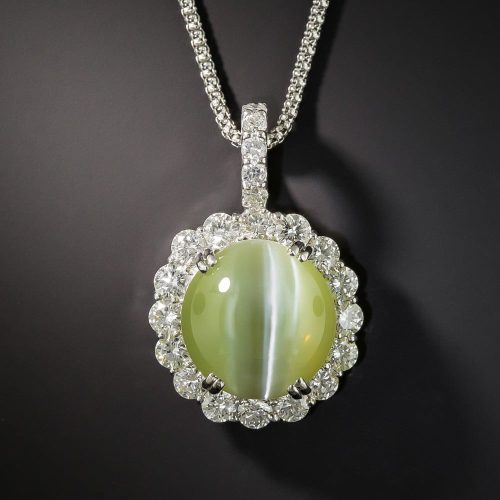
Chrysoberyl is among the most brilliant of gems and its hardness is only surpassed by diamonds and corundum. The name chrysoberyl derives from the Greek, meaning “Golden Beryl”, although, in reality, it is not a variety of beryl at all. Chrysoberyl is a beryllium aluminum oxide, whereas, the mineral beryl is a silicate. The chrysoberyl family includes some of the most valuable and desirable gems like alexandrite and chrysoberyl cat’s eye. Chrysoberyl most commonly occurs in transparent tones of yellow and green.
A Brief History of Chrysoberyl
Cat’s eye has the longest history of gems in the chrysoberyl family. It was treasured in Asia before the birth of Christ and became quite well-known in Rome by the end of the First Century. In the symbolic necklace of Vishnu, a green cat-eye chrysoberyl represented the magnetic center of human passion.
The popularity of Cat’s Eyes sky-rocked in the 19th Century after the Duke of Connaught presented his fiance with a cat’s eye betrothal ring. Ceylon, where most of the examples of cat’s eye were mined could not keep up with the overwhelming demand.
Alexandrite, the chameleon-like variety of chrysoberyl, was discovered in an emerald mine in the Ural Mountains in 1830 on the birthday of Czar Alexander II, after whom the gem was named.
The most common varieties of chrysoberyl occur in shades of transparent greenish-yellow. They are found predominately in Brazil and Sri Lanka. This variety was imported into Europe where it became very popular in Victorian and Edwardian jewels.



Gemological Information for Chrysoberyl
| Color: | Yellowish-green, yellow, brown. Alexandrite: blue-green to green red to purple color change |
| Crystal Structure: | Orthorhombic |
| Refractive Index: | 1.74 to 1.75, birefringence 0.008 to 0.010 |
| Durability: | Excellent |
| Hardness: | 8.5 |
| Family: | |
| Similar Stones: | Corundum, Citrine, Tourmaline, Garnet, Peridot |
| Treatments: | None |
| Country of Origin: | Sri Lanka, Brazil, Myanmar, Zimbabwe, Madagaskar, India |
Chrysoberyl Care
| Ultrasonic Cleaning: | Safe |
| Steam Cleaning: | Safe |
| Warm Soapy Water: | Safe |
| Chemical Attack: | Avoid |
| Light Sensitivity: | None |
| Heat Sensitivity: | Safe |
Gems & Gemology: The Quarterly Journal of The Gemological Institute of America.
Chrysoberyl
- 1934, Chrysoberyl, p. 9, 2pp.
- Winter 1937, A Grayish-Green Star Chrysoberyl, p. 130, 1p.
- Fall 1945, A 115 ct. Star Chrysoberyl (Non-Gem Quality), by Anderson, p. 252, 2pp.
- Spring 1949, The Origin of Alexandrite Color Change, p. 143, 3pp.
- Spring 1949, Chrysoberyl, p. 147, 1p.
- Fall 1953, Inclusions in Yellow Chrysoberyl, by Webster, p. 343, 4pp.
- Spring 1954, Separating Yellow Chrysoberyl and Yellow Corundum, p. 32, 1p.
- Spring 1959, A 45 ct., a 12 ct., and a 50 ct. Alexandrite, p. 264, 1p.
- Summer 1960, A 4-Rayed Star Brown Chrysoberyl, p. 62, 1p.
- Winter 1963, A Cat’s-Eye Alexandrite, p. 104, 2pp.
- Fall 1964, Synthetic Alexandrite Made, p. 216, 1p.
- Fall 1967, Cat’s-Eye Doublet, p. 215, 2pp.
- Summer 1970, High-Property Cat’s-Eye (R.I. 1.76–1.77), and Absorption Spectrum, p. 184, 2pp.
- Winter 1972, Synthetic Alexandrite, Introduced to the Market by Creative Crystals, Inc., Danville, Calif., p. 102, 3pp.
- Winter 1972, Chrysoberyl Cat’s-Eye, Proved to be Natural, p. 113, 1p.
- Winter 1972, Fine Cat’s-Eye Glass with Milk and Honey Effect, p. 108, 1p.
- Spring 1973, Fine Cat’s-Eye Glass and Optic Fibers with Milk and Honey Effect, p. 136, 3pp.
- Winter 1974, A New Synthetic Alexandrite by the Czochralski Method, p. 367, 3pp.
- Summer 1976, A Very Rare 4-Ray Star Cat’s-Eye Chrysoberyl, p. 170, 1p.
- Fall 1976, Alexandrite from Lake Manyara, Tanzania, by Gübelin, p. 203, 11 pp., with Bibliography
- Fall 1976, African Alexandrites?, p. 211, 3pp.
- Spring 1979, Natural & Synthetic Alexandrites, p. 148, 1p.
- Spring 1980, Fiber Optic Cat’s-Eye Imitation, p. 278, 1p.
- Summer 1980, A Giant Chrysoberyl Crystal, p. 320, 2pp.